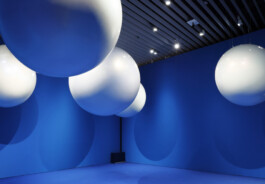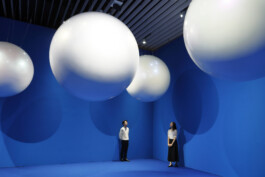



This installation reflects on the history of natural pearls and the oil industry, prompting contemplation about human intervention, exploitation of nature, and the coexistence of humanity and the environment. The Gulf region has a long history of obtaining wealth through the extraction of precious natural pearls since the Mesopotamian era, but this industry was eclipsed in the early twentieth century with the introduction of cultured pearls by Japan. Then subsequent development of oil resources led to economic growth. Tracing these histories, the artist has created a large body of work connecting pearls and oil as characters through their colors and forms. Here, the work reimagines the sustained destruction of nature as an act of supernatural haunting: the pearls themselves are portrayed as ghosts, each narrating a different phase of their disturbance: irritation, exploitation, manipulation, degradation, and transformation. This karmic view of our relationship to nature as a ‘haunting’ or ‘grudge’ gives a different perspective of how to deal with the concept of ecology in our modern environment, allowing us to reconsider the extent to which our actions reach.
Commissioned by Mori Art Museum




This installation reflects on the history of natural pearls and the oil industry, prompting contemplation about human intervention, exploitation of nature, and the coexistence of humanity and the environment. The Gulf region has a long history of obtaining wealth through the extraction of precious natural pearls since the Mesopotamian era, but this industry was eclipsed in the early twentieth century with the introduction of cultured pearls by Japan. Then subsequent development of oil resources led to economic growth. Tracing these histories, the artist has created a large body of work connecting pearls and oil as characters through their colors and forms. Here, the work reimagines the sustained destruction of nature as an act of supernatural haunting: the pearls themselves are portrayed as ghosts, each narrating a different phase of their disturbance: irritation, exploitation, manipulation, degradation, and transformation. This karmic view of our relationship to nature as a ‘haunting’ or ‘grudge’ gives a different perspective of how to deal with the concept of ecology in our modern environment, allowing us to reconsider the extent to which our actions reach.
Commissioned by Mori Art Museum